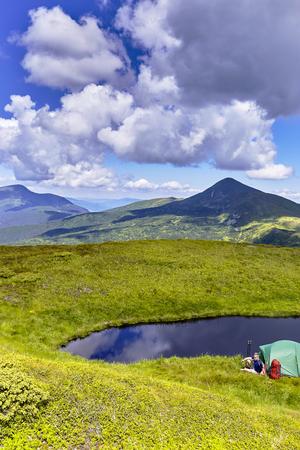Introduction to Wild Camping Around Scottish Castles
There’s nowhere in Britain quite like Scotland when it comes to wild camping. Imagine unzipping your tent at first light, the ancient stones of a brooding castle silhouetted against the morning mist, or falling asleep to the distant call of an owl echoing across a sprawling estate. Wild camping in the shadow of Scotland’s historic fortresses and grand baronial homes isn’t just about a night under canvas – it’s about stepping directly into the living, breathing pages of history. With landscapes shaped by centuries of clan battles, royal intrigue, and untamed nature, these settings offer more than just shelter; they provide an atmospheric backdrop that is both hauntingly beautiful and deeply evocative. For those with a taste for adventure, this is the kind of place where you can feel the weight of stories beneath your boots and sense the raw edge of wilderness blending seamlessly with civilisation’s remnants. Whether you’re drawn by rugged romance or the thrill of solitude amidst ancient walls, wild camping near Scottish castles promises an experience that stirs the spirit and sharpens your survival instincts like nowhere else in the UK.
2. Understanding the Scottish Outdoor Access Code
Wild camping in the haunting shadows of Scotland’s ancient castles and sprawling estates is a privilege shaped by the nation’s unique approach to land access. Underpinning this experience is the Scottish Outdoor Access Code—a legal framework that grants everyone the right to roam, provided it’s exercised responsibly. Before pitching your tent beneath battlements or beside estate walls, it’s essential to understand your rights, obligations, and the nuances specific to camping near these historic sites.
Your Legal Rights: The Right to Roam
Scotland’s Land Reform (Scotland) Act 2003 guarantees public access to most land and inland water for recreation, education, and passage. This includes wild camping, but with clear conditions:
| Aspect | Details |
|---|---|
| Where You Can Camp | Most unenclosed land; avoid private gardens, farmyards, and military grounds. |
| Castle & Estate Grounds | Permitted if not actively used as gardens or for private events; check for local restrictions or signs. |
Seeking Permissions Near Castles and Estates
While wild camping is generally allowed, respect for private property remains crucial. Many castles are still family homes or active estates. Always seek permission if you’re unsure or if signage indicates restricted access. Approach estate staff or owners courteously—most will appreciate your respect for their privacy and heritage.
Campsite Etiquette: Leave No Trace
- Camp in small numbers and only stay one or two nights in each spot.
- Avoid lighting fires near historic structures; use a stove instead.
- Set up camp late in the day and leave early, blending into the landscape as much as possible.
Conservation Practices
The landscapes around Scottish castles are often ecologically sensitive and culturally significant. Stick to established paths when approaching sites, avoid disturbing wildlife or livestock, and never remove artefacts or stones from castle grounds. Dispose of all litter—including biodegradable waste—responsibly. By following these principles, you help preserve Scotland’s wild beauty for future generations of adventurers.

3. Essential Gear & Survival Kit for Scottish Conditions
When wild camping in the brooding shadows of Scottish castles and remote estates, your kit is your lifeline. Scotland’s weather is famously fickle, with sunshine, torrential rain, and biting winds all possible in a single afternoon. Preparation isn’t just sensible—it’s survival.
The Right Shelter for Scottish Wilds
A four-season tent with a sturdy, low-profile design is non-negotiable; opt for something that can withstand howling gales and driving rain. A robust groundsheet is essential for boggy terrain common around ancient estates, while extra pegs and guylines are wise given the wind. If you’re seeking stealth near castle ruins or in estate woodland, choose muted colours—greens or browns—to blend with the landscape.
Clothing: Layering Against the Elements
Embrace the British love of layers. Start with a moisture-wicking base layer to keep sweat off your skin, add a thick insulating mid-layer (such as fleece or synthetic fill), and finish with a waterproof, breathable shell jacket and trousers. A wool beanie, waterproof gloves, and thermal socks will stave off Scotland’s chill—even in summer months. Spare dry clothes are crucial; store them in dry bags to ensure they remain untouched by sudden downpours.
Survival Essentials & Technical Tools
Your survival kit should include a reliable head torch (plus spare batteries), an Ordnance Survey map and compass (never rely on phone signal alone), and a sturdy fixed-blade knife for bushcraft tasks. A lightweight stove and fuel will let you brew up hot tea—a true British comfort when the mist rolls in. Carry high-energy food like oatcakes and flapjacks for quick sustenance. Don’t forget a water filter or purification tablets; many burns and lochs near castle grounds look pristine but can harbour unseen contaminants.
Practical Tips for Rugged Scottish Ground
Always pack midge repellent and a fine mesh head net—Scottish midges are notorious from May to September and can ruin any camp. Gaiters will save your lower legs from sodden heather and ticks when navigating through estate moorland. Finally, respect local access codes: pitch late, leave early, and never camp within sight of occupied dwellings or castle ruins without landowner permission. With the right kit and know-how, you’ll thrive in the wild heart of Scotland—whatever the weather throws at you.
4. Best Practices: Choosing a Campsite in Castle Country
When wild camping near Scotlands storied castles and grand estates, your choice of campsite is more than just a matter of comfort—its about blending survival instincts with profound respect for local heritage and the land itself. Here’s a step-by-step guide to making wise, low-impact decisions while setting up camp in these legendary landscapes.
Step 1: Research Your Area
Before you lace up your boots, take the time to study maps and local guidance. Avoid camping on private land without permission, especially near inhabited estates. Many castle grounds are protected or in regular use—check for access rights under Scotland’s Outdoor Access Code and consult online forums frequented by seasoned wild campers.
Step 2: Seek Seclusion Without Trespassing
Privacy is paramount. Choose locations out of sight from castle windows, estate tracks, and tourist routes. Position yourself at least 200 metres from any building and avoid manicured gardens or farmland to prevent disturbing daily operations or drawing unwanted attention.
Step 3: Assess Safety and Shelter
Scottish weather is famously unpredictable. Seek natural windbreaks—such as low stone walls or woodland edges—but avoid ancient trees that may shed limbs or areas prone to flooding. Keep away from cliff edges or unstable terrain surrounding old ruins.
Campsite Selection Checklist
| Consideration | What to Look For |
|---|---|
| Privacy | Hidden from paths, buildings, & visitor lines of sight |
| Safety | Sheltered from wind, away from hazards (cliffs, rivers) |
| Impact | No disturbance to flora, fauna, or archaeological features |
| Leave No Trace | Pitches where traces can be erased easily on departure |
| Respect | Avoiding sacred sites & fragile historical structures |
Step 4: Minimise Environmental Impact
Stick to resilient ground—short grass, dry heath, or gravelly soil—to avoid trampling delicate habitats. Never pitch on ancient earthworks or obvious archaeological remains. If fires are essential for survival, use a raised stove and keep it small; Scottish law forbids open fires in many protected areas.
Pro Tip:
If you’re unsure about an area’s status or sensitivity, err on the side of caution—move further afield rather than risk damaging heritage or wildlife.
Step 5: Plan Your Exit Strategy
Wild camping’s golden rule is “leave no trace.” Pack out all rubbish, restore disturbed turf, and brush out tent marks. Early morning departures reduce the chance of encounters with estate staff or tourists—helping maintain good relations between campers and landowners.
By following these best practices when choosing your wild campsite in castle country, you’ll not only secure your own safety and solitude but also honour the timeless spirit of Scotland’s historic landscapes.
5. Cultural Etiquette and Local Interactions
When wild camping in the shadows of Scottish castles and grand estates, your approach to local etiquette can make or break your experience. Scotland’s unique “right to roam” is a privilege, not an entitlement—respect for landowners, estate staff, and local customs is essential for harmonious adventures.
Initiating Contact with Landowners and Estate Staff
If your chosen wild camping spot lies near a castle, manor, or estate grounds, it’s best practice to introduce yourself to the landowner or the appointed gamekeeper. In Scotland, these individuals are often referred to as the “Laird” (landowner) or “Factor” (estate manager). Approach politely, remove your hat as a sign of respect if appropriate, and offer a courteous greeting such as, “Good afternoon, sir/madam. I hope you don’t mind my pitching up nearby for a night.” This small gesture can go a long way toward securing goodwill.
Using Proper British Terminology
In conversations, refer to wild camping as “wild camping” rather than “free camping,” and mention you are following the Scottish Outdoor Access Code. Ask for directions using terms like “track” instead of “trail,” and refer to fields as “meadows” or “pasture.” When discussing weather—a favourite British pastime—use local expressions: “dreich” for dreary weather or “a wee bit windy.”
Blending in with Scottish Customs
Scottish hospitality is legendary but reserved; avoid being overly familiar. Accepting a dram of whisky if offered is a mark of respect, but never overindulge on someone else’s generosity. Always leave gates as you find them—open or closed—and keep dogs under control. A simple nod or a friendly “cheers” when passing locals on footpaths goes a long way. If invited into conversation, listen more than you speak; Scots value humility and genuine interest in their heritage.
Respectful Camping Practices
Pitch your tent discreetly out of sight from main buildings and pathways. Avoid lighting open fires unless explicitly permitted by the landowner—use a portable stove instead. Upon departure, leave no trace whatsoever: pack out all litter, restore disturbed ground, and leave the place better than you found it. By observing these customs and showing proper respect for people and place alike, you’ll ensure your wild camping adventure remains welcome in the rugged beauty surrounding Scotland’s storied castles and estates.
6. Weathering the Elements: Survival Tips for the Scottish Wilds
If you’re wild camping in the brooding shadows of Scotland’s ancient castles and grand estates, expect the weather to test your mettle. The Scottish climate is legendarily fickle—one moment you’re basking in golden sunbeams, the next you’re lashed by horizontal rain. To thrive rather than merely survive, here are essential, actionable tips tailored for these storied landscapes.
Mastering the Rain and Wet Ground
Scotland’s downpours can soak through even the sturdiest kit if you’re not prepared. Always opt for a high-quality, fully waterproof tent with a robust groundsheet—pitch on elevated ground away from castle ruins or estate walls where runoff pools. Keep your sleeping bag dry by using a compression sack lined with a bin liner as an added barrier. Waterproofs aren’t optional; pack breathable, seam-sealed jackets and trousers. Dry bags will be your best mate for keeping electronics and spare clothes safe.
Defeating the Midges
When dusk falls near lochs and low-lying meadows, midges descend like a medieval army. Shield yourself with midge nets over hats and treat exposed skin with repellent containing DEET or natural alternatives like citronella. Camp in breezy spots where possible—the little blighters struggle against even a modest wind. Avoid pitching too close to stagnant water or dense shrubbery near estate grounds, where midges breed en masse.
Fire Safety on Historic Land
A campfire’s warmth is tempting after a day exploring castle ruins, but safety and respect are paramount. Never light fires within view or within grounds of protected sites—Scotland’s heritage laws are strict, and damage could be irreversible. Use a raised fire pit or portable stove well away from old stonework, dry bracken, or estate fences. Always have water ready to douse flames completely and clear up all traces before leaving.
Emergency Navigation Skills
Mist can roll across moorland in moments, turning familiar terrain into a maze. Carry both OS maps and a compass as GPS signals often fail near thick-walled ruins and deep valleys. Mark your location before heading out to explore—note landmarks such as gatehouses, distinctive trees, or outbuildings. Share your plans with someone back home and keep a charged power bank handy for emergencies.
Final Word: Respecting Scotland’s Wilderness Legacy
The wild lands surrounding Scotland’s castles demand humility as much as preparation. Leave no trace—pack out every scrap of rubbish, avoid disturbing wildlife, and respect estate boundaries and local access codes. Survive well, tread lightly, and you’ll find wild camping in these historic shadows becomes a story worth retelling round any campfire.
7. Unique Experiences: Exploring Scotland’s Myths, History, and Wildlife
Wild camping beneath the looming silhouettes of Scottish castles is more than a test of endurance; it’s a passage into a land where myth and reality intertwine. As dusk settles over ruined battlements and mist creeps along the moors, you’ll sense the weight of centuries pressing close. Here, every shadow might hide the echo of a ghostly piper or the fleeting form of a kelpie—those legendary water spirits said to haunt lochs and streams. Embracing these tales isn’t just for atmosphere; it sharpens your awareness, making you attuned to the subtle changes in wind, the hush of distant footfalls, or the eerie call of an owl overhead.
Survival Skills Rooted in Tradition
Generations of Scots have survived these rugged lands by respecting both nature and legend. Setting camp near ancient estates demands discretion and sensitivity—selecting ground that won’t be easily discovered by wandering estate rangers or disturbed by restless spirits reputed to guard their ancestral homes. Always pitch low-profile shelters and use natural features as windbreaks, just as Highlanders once did while evading enemies or seeking shelter from brutal weather.
Wildlife Encounters on Ancestral Lands
The same landscapes that spawned legends teem with life. At dawn, red deer graze silently on dew-soaked grass within sight of crumbling stone towers. Pine martens slink through woodland edges, while golden eagles circle high above castle ruins. Respect these inhabitants; maintain distance and avoid feeding them. Store food securely—both to protect yourself from opportunistic badgers and to uphold Leave No Trace principles vital to preserving this wild heritage for future generations.
Blending Modern Know-How with Ancient Lore
Success in wild camping here means blending hard-earned survival skills—like firecraft using local birch or river stones for makeshift stoves—with a deep appreciation for local culture. Listen for stories in village pubs before heading out; locals often know which ruins are best avoided after dark or which glens hold secrets yet untold. Carry a torch not only for safety but to respect traditions: many believe a lighted lantern wards off mischievous spirits on moonless nights.
Ultimately, wild camping in the shadows of Scottish castles offers an experience unlike any other—a raw communion with landscape, legend, and life. Each night spent beneath these ancient stones forges a connection between present-day adventurer and the countless souls who found refuge—and wonder—here before.


